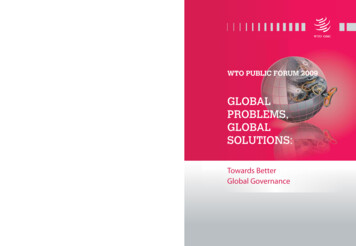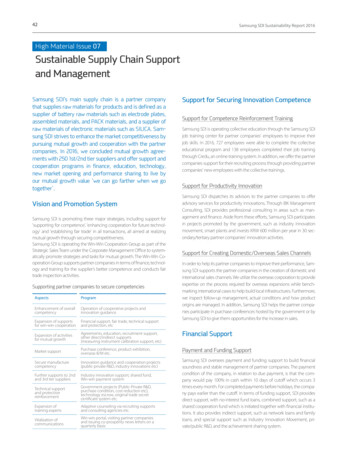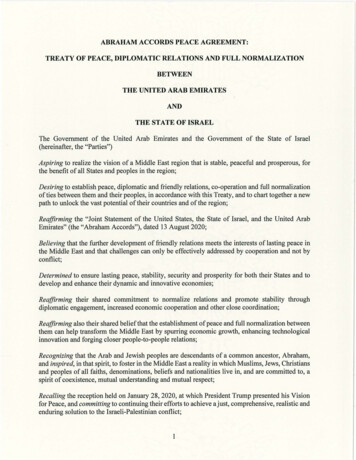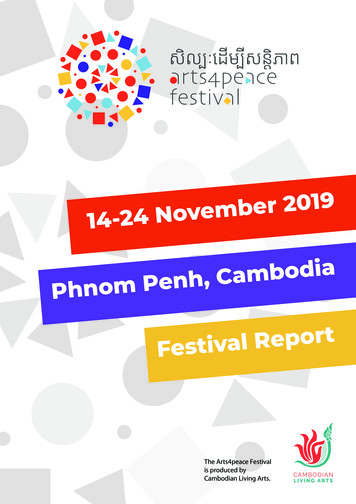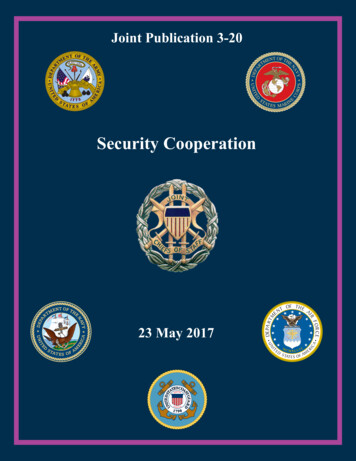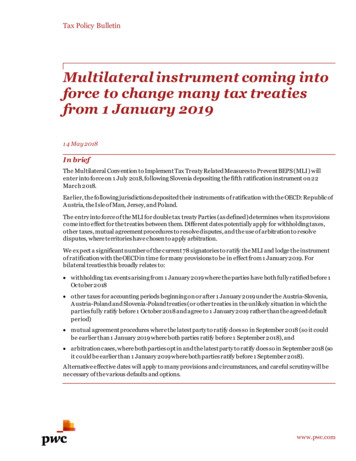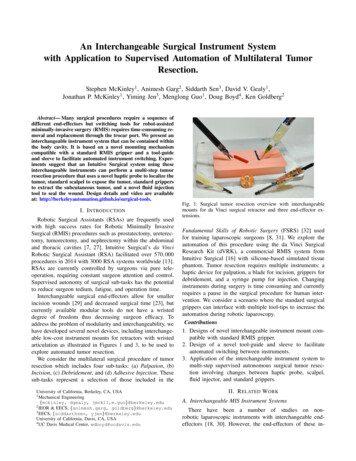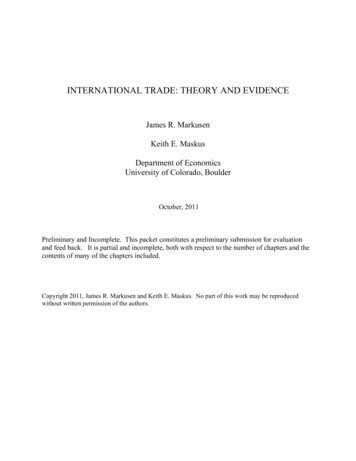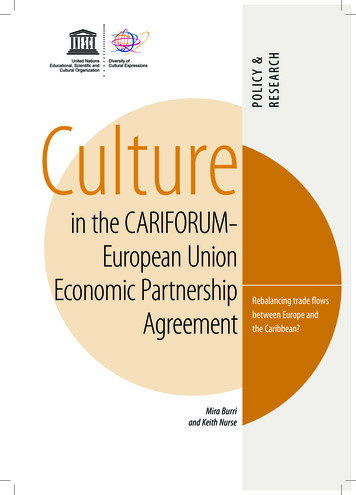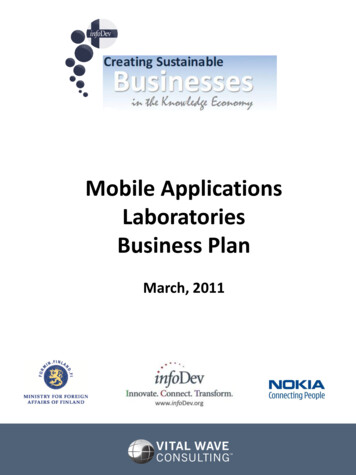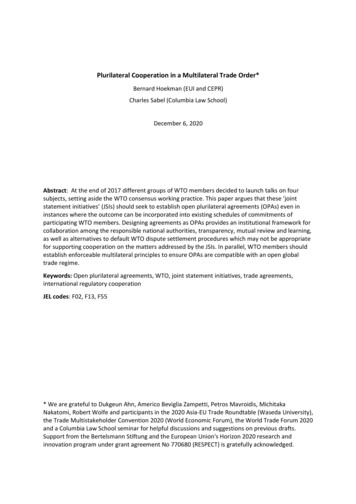
Transcription
Plurilateral Cooperation in a Multilateral Trade Order*Bernard Hoekman (EUI and CEPR)Charles Sabel (Columbia Law School)December 6, 2020Abstract: At the end of 2017 different groups of WTO members decided to launch talks on foursubjects, setting aside the WTO consensus working practice. This paper argues that these ‘jointstatement initiatives’ (JSIs) should seek to establish open plurilateral agreements (OPAs) even ininstances where the outcome can be incorporated into existing schedules of commitments ofparticipating WTO members. Designing agreements as OPAs provides an institutional framework forcollaboration among the responsible national authorities, transparency, mutual review and learning,as well as alternatives to default WTO dispute settlement procedures which may not be appropriatefor supporting cooperation on the matters addressed by the JSIs. In parallel, WTO members shouldestablish enforceable multilateral principles to ensure OPAs are compatible with an open globaltrade regime.Keywords: Open plurilateral agreements, WTO, joint statement initiatives, trade agreements,international regulatory cooperationJEL codes: F02, F13, F55* We are grateful to Dukgeun Ahn, Americo Beviglia Zampetti, Petros Mavroidis, MichitakaNakatomi, Robert Wolfe and participants in the 2020 Asia-EU Trade Roundtable (Waseda University),the Trade Multistakeholder Convention 2020 (World Economic Forum), the World Trade Forum 2020and a Columbia Law School seminar for helpful discussions and suggestions on previous drafts.Support from the Bertelsmann Stiftung and the European Union's Horizon 2020 research andinnovation program under grant agreement No 770680 (RESPECT) is gratefully acknowledged.
IntroductionSince its establishment in 1995 the WTO has had little success in negotiating new disciplines on theuse discriminatory trade policies. Instead, new rulemaking has been occurring in deep preferentialtrade agreements (PTAs) (Dür, Baccini and Elsig, 2014). While beneficial to participating countries,deep PTAs are inherently constrained in addressing international policy spillovers given that majoremerging economies have not been willing to participate in them. Such spillovers have beenincreasing, reflecting a steady rise in competition-distorting trade measures in the last decade(Evenett, 2019), many of which are only partially subject to WTO disciplines, if at all. The inability to(re-)negotiate multilateral rules has led to trade conflicts, notably between the US and China, andimpeded cooperation to address global market failures and use trade policy for sustainabledevelopment.Consensus-based decision-making has been a factor inhibiting the ability of the WTO to engage indeliberations on new agreements. At the December 2017 Ministerial Conference, groups of WTOmembers abandoned the long-standing consensus working practice and launched four “jointstatement initiatives” (JSIs) spanning e-commerce, domestic regulation of services, investmentfacilitation, and measures to enhance the ability of micro and small and medium enterprises(MSMEs) to utilize the trade opportunities.1 This shift to plurilateral engagement offers analternative to the negotiation of (deep) PTAs to countries seeking to bolster trade governance byproviding a mechanism for countries to cooperate on an issue-specific basis without having toliberalize substantially all trade. In doing so it creates opportunities for cooperation withoutrequiring all 164 WTO members to agree.This paper reflects on the question whether and how plurilateral cooperation can revitalize theWTO, focusing on the JSIs. It builds on a previous article (Hoekman and Sabel, 2019) on openplurilateral agreements (OPAs) as a vehicle to support international regulatory cooperation in theWTO, arguing that JSIs should be conceptualized as OPAs, complementing the trade agreements thatto date have been the staple of the WTO. The paper is organized as follows. Section 1 brieflydiscusses the ongoing JSI talks in the WTO and recent plurilateral trade initiatives outside the WTO.Section 2 presents a typology of trade-related cooperation to address different types of problems.Section 3 applies the typology to the JSIs and argues that OPAs provide a useful institutionalframework to support the implementation of what is agreed in negotiations. Section 4 discussesgovernance principles that could be applied by WTO members to OPAs to ensure plurilateralinitiatives are consistent with an open rules-based multilateral trading system. Section 5 concludes.1. The nascent shift to plurilateral initiativesPlurilateral cooperation is not new for the WTO. Many WTO agreements are the outcome ofnegotiations among the ‘principal suppliers’ of products and the principal ‘demandeurs’ for rulespertaining to a given area of trade policy. Although the practice has been to pursue cooperationthrough large ‘rounds’ that encompass many policy areas to permit cross-issue linkages andtradeoffs with a view to satisfying the Pareto criterion and increasing the potential gains fromcooperation, in the GATT years there were several agreements that bound only signatories, rangingfrom anti-dumping to product standards. Almost all came to be incorporated as multilateral1https://www.wto.org/english/news e/news17 e/minis 13dec17 e.htm.1
agreements when the WTO was created in 1995, but GATT practice illustrates that plurilateralagreements are nothing new for the trading system.2The JSIs span a cross-section of the WTO membership. The US participates in one (e-commerce).China and the EU participate in all four.3 Independent of whether a WTO member is a sponsor of agroup, deliberations are open to all WTO members. The E-commerce JSI talks involve 80 WTOMembers. Most are middle- and high-income nations.4 The focus of deliberation is on a mix of traderestrictive policies and digital trade facilitation.5 The former include regulation of cross-border dataflows and data localization requirements, the latter include issues like electronic signatures, einvoicing, facilitating electronic payment for cross-border transactions, and cooperation onconsumer protection (e.g., combatting fraud).Services domestic regulation talks involve 60 WTO Members and center on matters associated withauthorization and certification of foreign services providers (licensing, qualification, and technicalstandards), not on substance of regulations. The aim is to reduce the trade-impeding effects ofdomestic regulation by enhancing transparency of policies through enquiry points; establishing goodpractice timeframes for processing of applications; acceptance of electronic applications by serviceproviders, use of objective criteria, ensuring national authorizing bodies are independent andimpartial, and mechanisms for foreign providers to request domestic review of decisions.Neither e-commerce or services regulation are new for the WTO. Both have been discussed since thelate 1990s. A WTO work program on e-commerce was initiated in 1998, and a Working Party onDomestic Regulation was established in 1999. These work programs were anchored in existing WTOtreaties. In the case of e-commerce this spans all three of the major WTO multilateral agreements –GATT, GATS, and TRIPS. The mandate of the working party on domestic regulation of services was todevelop horizontal (cross-sectoral) disciplines called for in Art. VI GATS.The MSME and investment facilitation groups differ from the other two JSIs in not being tied tospecific existing WTO agreements. The informal working group on MSMEs includes 90 WTOmembers.6 The aim is to identify measures governments can take to support internationalization ofsmall firms. Recommendations to this effect will not be mandatory but be open to participating WTOmembers to adopt on a voluntary basis.7 Talks on investment facilitation were launched by some 70WTO Members in Buenos Aires in 2017 and grew to encompass more than 100 participants in late2020.8 The agenda excludes liberalization of inward FDI policies, measures related to protection offoreign investors and investor-State dispute settlement. The focus is solely on facilitation. Allinvestment is covered, including services, i.e., facilitation of mode 3 is part of the discussion. Talkscenter on “good regulatory practices” such as transparency and predictability of investment-related2See, e.g., Hoekman and Kostecki (2009).China was a co-sponsor of three of the four groups in 2017. Initially China did not participate in the JSI on ecommerce, but it joined subsequently.4As of end 2020, only five African countries participated: Benin, Cameroun, Cote d’Ivoire, Kenya and Nigeria.5For a summary of the issues that have been tabled by different participants, see ls-aimed-at-advancing-exploratory-e-commerce-work/ and Ismail (2020).3678https://www.wto.org/english/news e/news20 e/msmes 05nov20 e.htmSee Campos-Leal et al. (2020).https://www.wto.org/english/news e/news19 e/infac 05nov19 e.htm. See Baliño et al. (2020).2
polices; streamlining administrative procedures; soliciting feedback on proposed regulatorymeasures; information sharing on best practices and ex post monitoring and evaluation (learning).Outside the WTO, groups of countries have also begun to negotiate plurilateral agreements that aredistinct from PTAs to address trade-related matters and nontrade policies. Examples include theDigital Economy Partnership Agreement between Chile, New Zealand and Singapore,9 the DigitalEconomy Agreement between Australia and Singapore,10 the Japan-US Agreement on Digital Trade,11and negotiations between Singapore and South Korea on a digital partnership agreement.12Observers have proposed extending such arrangements to create a ‘single data areas’ encompassinglike-minded countries (Leblond and Aronson, 2019). Beyond the digital arena, there are ongoingnegotiations between New Zealand and includes Costa Rica, Fiji, Iceland, Norway, and Switzerlandon a plurilateral Agreement on Climate Change, Trade and Sustainability (ACCTS).13 The Asia-Pacificdigital agreements build on the e-commerce chapters of the Comprehensive and ProgressiveAgreement on Trans-Pacific Partnership (CPTPP) and bilateral PTAs. The purported goal of the ACCTSis to negotiate an open plurilateral agreement, in the process demonstrating that countries canagree on how trade policy and trade rules can help drive the transformation of the economy tobecome more sustainable and inclusive.2.Horses for coursesPlurilateral initiatives differ from traditional trade agreements in that (i) they are issue-specific orcombine a small number of policy issues and (ii) do not center (solely) on liberalization of marketaccess barriers. They raise important conceptual – and practical – questions regarding the incentiveconstraints facing participants that determine the feasibility of negotiating and implementingagreements.Trade agreements have four salient characteristics that are relevant from the perspective ofconsidering when and how they may support – or impede – cooperation to reduce cross-bordernegative policy spillovers. First, they liberalize access to markets through a process of reciprocalexchange of trade policy concessions. Reciprocity permits internalization of the benefits ofliberalization. Second, they rely on the national treatment principle to prevent ‘concession erosion’ –the use of domestic policies to substitute for trade policies, while leaving parties free to define theirdomestic regulations as they wish as long as regulation is applied equally to domestic and foreignagents. Third, there is a focus on trade facilitation as well as liberalization, i.e., efforts to reduce9Chile, New Zealand and Singapore (2020); alia and Singapore (2020); y-agreement11The agreement bans data localization, barriers to cross-border data flows and conditioning access to themarket on transfer of source code or algorithms, and covers financial services. ements/japan/Agreement between the United States and Japan concerning Digital ility-at-the-world-economicforum-davos-2020/3
trade costs through transparency and identification of good policy practices. Fourth, they are selfenforcing: the threat of withdrawal of market access commitments (retaliation) is the mechanismused to sustain cooperation.An implication of these characteristics is that by design most PTAs are shallow integrationinstruments in the sense that signatories retain national regulatory sovereignty: they are free toregulate as they wish as long as measures conform to the national treatment and most-favorednation (MFN) principles. ‘Deeper’ PTAs go beyond the four basic characteristics by includingprovisions on the substance of domestic regulation, intellectual property rights, foreign investment,and product and factor markets more broadly. Deeper integration touches on matters that are ofinterest to a much broader constellation of domestic interest groups and is therefore – appropriately– more politically sensitive and complex than shallow trade agreements. However, the core featureof all PTAs – shallow or deep – is preferential liberalization of market access barriers.In addition to PTAs, the WTO envisages two other forms of plurilateral cooperation among memberson a sector- or issue-specific basis. In contrast to a PTA, neither requires liberalization ofsubstantially all trade between signatories. The first alternative is to conclude a plurilateralagreement under Art. II.3 WTO. The second is to negotiate a so-called critical mass agreement(CMA). In both cases negotiated disciplines apply only to signatories. They differ in that the benefitsof CMAs apply on a nondiscriminatory basis to all countries, including non-participating nations,whereas Art. II:3 plurilateral agreements do not. An example of a CMA is the Information TechnologyAgreement (ITA). The main example of an Art. II plurilateral is the Agreement on GovernmentProcurement (GPA).In considering different types of trade cooperation, countries must determine whether free-ridingconstraints apply and, if so, what constitutes a critical mass of participation that internalizes enoughof the benefits within the participating group of countries. CMAs are only feasible if most of thebenefits associated with trade liberalization are internalized by participants. If not, the WTO MFNrequirement will preclude agreement. This constraint can be difficult to overcome, as shown by ITAnegotiations and the talks on an Environmental Goods Agreement (EGA) to reduce tariffs onproducts salient for reducing carbon emissions, which have yet to be concluded.14 The ITAdemonstrates that CMAs can be negotiated, but also that a necessary condition is that enoughproducts are covered and a large enough set of countries participate.15The top part of Table 1 characterizes these different types of trade agreements: multilateral packagedeals (trade rounds), PTAs, CMAs and Art. II plurilateral agreements. All involve policy commitmentsand international cooperation among signatories. All address policies that by design discriminate andimpede market access. The bottom part of Table 1 presents forms of cooperation that are domainspecific, where the primary focus is not on liberalization (constraining the use of discriminatorypolicies). Such cooperation can take the form of harmonization (e.g., a commitment to develop andadopt common standards), implementing agreed good regulatory practices, and mutual recognitionof equivalence of regulatory regimes. Cooperation will often have a market access dimension, butthe focus is on domestic regulation.14Mavroidis and Neven (2019) and De Melo and Solleder (2020) assess reasons for the difficulties inconcluding the EGA negotiations successfully.15Gnutzmann-Mkrtchyan and Henn (2018) analyze the economic dimensions of the ITA.4
Table 1 Alternative Instruments for CooperationCharacteristics of cooperation outcomeType of cooperationType 1: TradeagreementsBinding State-toState treaties withfixed terms andbinding, selfenforcing disputeresolutionType 2:Open plurilateralcooperationSeverable, flexible,dynamic, issuespecificMain issueDiscriminatorypoliciesaffectingmarket accessRegulatoryheterogeneityType of spillover“Terms of trade”effects oftrade/industrialpoliciesPecuniaryspilloversCross bordereffects ofdomesticregulatory policiesNon-pecuniaryspilloversNondiscrimination (MFN)Benefits limited to participantsMulti-issue multilateral agreements(Uruguay and Doha rounds)Reciprocal preferential trade agreements (PTAs)Issue-specific critical mass agreements(e.g. Information Technology Agreement;GATS Telecom Reference paper;Environmental Goods negotiations)Issue-specific, discriminatory plurilateralagreements under Art. II WTO(e.g. Government Procurement Agreement)Open, nondiscriminationOpen, conditional applicationInternational standard setting (ISO, CodexAlimentarius, UNECE)Mutual recognition (conformity assessmentagreements)Good regulatory practices (OECD; APEC)Open plurilateral agreements (OPAs) Digital Economy Partnerships COVID-19-related public healthagreements New WTO clubs5Regulatory equivalence regimes(Unilateral: EU data adequacy findingsBilateral: air safety agreements; EU Forest LawEnforcement, Governance and Trade regimeClubs with trade penalty defaults(e.g., Agreement on Climate Change, Trade &Sustainability negotiations)
The benefits of cooperation may apply unconditionally to all countries on a nondiscriminatory basisor on a conditional basis. Examples of the former include collaborative efforts in fora such as theOECD and APEC to define good regulatory practices and agreement by countries to adopt these.They also include international collaboration to develop product and process standards in intergovernmental bodies such as the ISO. Cooperation involving identification and agreement on goodregulatory practices can be applied on an unconditional MFN basis as it is insensitive to free ridingconsiderations: the policies are in the self-interest of countries independent of whether othercountries do so.In many cases cooperation is likely to require joint action by the parties. Such conditionality can varyin depth and intensity, ranging from low to medium to high forms. A low form example is mutualrecognition of conformity assessment mechanisms. A medium form is what Mattoo (2018) callsdestination-specific exporter regulatory commitments, where a regulator (government) accepts tolook after the interests of consumers in countries to which firms under its jurisdiction export (asdefined by the regulatory authorities in the importing nations), without necessarily adopting anidentical regulatory regime.16 A high form of conditionality is a regulatory equivalence regime, inwhich the regulators establish that regimes pursue similar objectives and are implemented so as toachieve the shared goal, permitting two-way flow of the goods or services concerned. Countries thatdo not have adequate regulatory capacity and enforcement institutions will not be able to benefitfrom mutual recognition, let alone equivalence arrangements.3. Fitting JSIs into the WTOAn important question confronting JSI participants is the form of cooperation that is envisaged. TheJSIs provide an opportunity to create OPAs, thereby demonstrating the capacity of the WTO toencompass variable geometry and cooperate on a nondiscriminatory basis. However, the JSI talksare not explicitly aimed at negotiating OPAs. As mentioned, the MSME initiative is not aimed toresult in a binding agreement, but is limited to ‘soft law’, best endeavor-type commitments that willbe embodied in a Ministerial declaration signed by participating countries. The JSIs on e-commerceand services domestic regulation are linked to existing WTO agreements and the outcome ofnegotiations may be embedded in participating WTO members’ schedule of commitments asopposed to a distinct agreement. Scheduling in the GATT and/or GATS is less of an option for theoutcome of investment facilitation talks.Inscribing the results of negotiations into participants’ GATT and/or GATS schedules will insulatesignatories from legal challenges by nonsignatories to whatever is agreed by participants, asscheduling ensures that implementation will occur on a nondiscriminatory basis (Hoekman andMavroidis, 2017). At the same time embedding JSI outcomes into national schedules makes theprovisions enforceable through the WTO Dispute Settlement Understanding (DSU). This may haveimplications for the feasibility of cooperation that goes beyond the need for attaining critical mass toaddress free riding concerns if this is a concern. As discussed below, the DSU may not be the mostappropriate instrument to support implementation of agreements that go beyond disciplining the16One can ask what the incentive is for the importing country to negotiate an agreement to this effect, insofaras it can – and presumably will – impose its domestic standards on imports. One possible reason is agreementpermits cross-issue linkages to be made; another is that agreement may assist the exporting country to obtainassistance in strengthening institutional capacity needed for implementation.6
use of discriminatory policies. Explicitly conceiving and designing the substantive elements of what isagreed in the JSIs as an OPA could help to support successful cooperation by specifying enforcementmechanisms that are better designed to serve the purpose of signatories to an agreement.OPAs differ from ‘standard’ trade agreements – ‘Type 1 cooperation’ – in at least four ways(Hoekman and Sabel, 2019). First, OPAs are open to participation of any country able to satisfy themembership conditions, in contrast to PTAs that generally are closed to access by new countries.Second, insofar as OPAs address trade costs created by regulatory heterogeneity they do not lendthemselves to quid pro quo exchange of concessions – what Bhagwati (1988) terms first differencereciprocity. Third, because they are domain specific, OPAs involve narrower and more limitedcommitments. A member must only undertake to meet the requirements that have been agreed forthe issue or class of goods and services concerned. Insofar as an OPA requires only equivalentperformance—not identical procedures or institutions—they permit members to produce therequired outcome through their own regulatory regimes and institutions. Fourth, and related,implementation of OPAs calls for continuing reciprocal review of existing regulatory policies andtheir implementation, and joint evaluation of potential adaption to changes in circumstances. Thepotential for learning through regular interactions between regulators and/or a broader epistemiccommunity involved in a policy area may also arise in the implementation of trade agreements but isless of a central feature given the narrow focus on disciplining discrimination.An implication of these different features is that OPAs may require less in the way of cross-issuelinkage to permit cooperation. This is an explicit feature of the New Zealand, Chile and SingaporeDigital Economy Partnership Agreement which is conceived to be open to any country interested injoining, and to facilitate participation through a modular design, allowing signatories to opt in or outof modules. This is very different from a standard trade agreement. A basic feature of all types oftrade agreements is that they involve cross-issue linkages.17 If a proposed agreement reduceswelfare for a country, linkage will be needed to satisfy the Pareto criterion, permitting cooperation ifthe benefits from including another subject exceed the losses associated with the initial proposal.Linkage may take many forms, including adding/subtracting issues, compensation mechanisms andside-payments.18 Maggi (2016) identifies three types of issue linkage in international agreements:negotiation linkage; enforcement linkage and participation linkage. All three are features of tradeagreements. The first of these involves negotiating two or more issues in one agreement, with thepossibility of trade-offs across issues, the goal being to conclude one agreement – a package dealthat is Pareto sanctioned: all participants are better off. Given agreement, enforcement linkageinvolves action in one issue area to enforce compliance with commitments in another (crossretaliation). An example is conditioning preferential access to the market on reform andenforcement of labor standards or protection of human rights.19Participation linkage comprises situations where the threat of sanctions in one area inducesparticipation in an agreement addressing another policy area. All three types of linkage fall under17See e.g., Conconi and Perroni (2002) and Limão (2005).18On iossue linkage and international cooperation see Haas (1980), Sebenius (1983), McGinnis (1986).A feature of nonreciprocal trade preference programs in which richer countries grant poorer countries betteraccess to their markets without requiring the latter to offer reciprocity in terms of market opening is thatconditionality may be imposed in other policy areas – i.e., there is cross-issue linkage. See e.g., Borchert et al.(2020).197
the broader concept of conditionality – making cooperation in one area a condition for cooperationin another. Conconi and Perroni (2002) contrast this notion of conditionality with a separation rule,in which there are explicit prohibitions on using sanctions in one area to induce (enforce)cooperation in another. OPAs are a mechanism to assure separability. Cooperation is severable inthe sense that if (part of) an OPA fails this need not affect cooperation in other areas.Issue linkage may increase overall potential gains, but as demonstrated by the failure of the Doharound, crafting a negotiating agenda that delivers large enough net gains to all parties is difficult.This is true especially if there are groups that lose from agreement to cooperate on a given policyarea. While overall, in the aggregate, there may be welfare (real income) gains, in the absence ofcredible and effective compensation for specific losses, negatively affected groups have good reasonto oppose a proposed deal. If policies are separable, cross-issue linkage is not needed – the payoffsof cooperation are independent of what governments may or may not do in other policy areas.Trade agreements are self-enforcing – the threat of withdrawing concessions sustains cooperation.There is no need for enforcement linkage. Binding dispute settlement enforced by the (threat of)withdrawal of market access is unlikely to be useful for encouraging cooperation on regulatorymatters. It is more likely to have a chilling effect on the willingness to consider cooperation – due tofear of uncertain contingent liability or views by regulators that market access considerations willhave adverse effects on the realization of regulatory goals.20 Different systems are needed, based ontransparency mechanisms (information collection, incident reporting, sharing of data, dialogue) and,as Hoekman and Sabel (2019) argue, severability. The latter is a feature of the CPTPP chapter onregulatory coherence which is not subject to binding dispute resolution. This was also taken off thetable by the EU in the aborted TTIP talks.Enforcement linkages may be required in domain-specific cooperation where the aim is tointernalize negative cross-border spillovers. These may be pecuniary or nonpecuniary. Examplesinclude policy areas such as subsidies, activities of state-owned enterprises (SOEs), digital economypolicies and cooperation in the use of trade policies to reduce national carbon footprints. In suchcases retaliation within the domain of the policy area is not desirable. Enforcement linkage is neededinstead.The domain-specific nature of OPAs and limited salience of enforcement mechanisms that rely onthe threat of ceasing to apply what was agreed implies a need for variable geometry when it comesto enforcement. If cooperation involves implementation of good practices and a party to an OPAcomes to believe that other approaches should be applied, this calls for discussion between partiesto assess the reasons underlying a decision to pursue a different path. Matters are different forcooperation centering on polices that generate negative international spillovers, where the threat ofretaliation may be effective. The upshot is that careful consideration is needed both when designingthe substance of an agreement and the type of enforcement mechanism that is appropriate.The Working Party on Domestic Regulation that was the precursor to the JSI on services regulationproved unable to achieve consensus on criteria determining whether (when) restrictions on trade20Such concerns were an important factor in the demise of talks in the WTO on competition policy in the early2000s. Competition authorities held the view that their mandate was to safeguard consumer interests, thecontestability of markets and national welfare. In doing so, they do not distinguish between the behavior ofdomestic and foreign firms on the market, as opposed to the focus of trade negotiators on improving conditionsof competition for national firms.8
are needed to attain a regulatory objective and whether disciplines should encompass privatestandard-setting bodies (Delim
agreements when the WTO was created in 1995, but GATT practice illustrates that plurilateral agreements are nothing new for the trading system.2 The JSIs span a cross-section of the WTO membership. The US participates in one (e-commerce). China and the EU participate in all four
